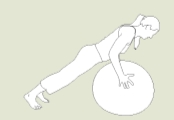
The Shoulder, Part III





The rotator cuff muscles are not balanced in their ability to internally or externally rotate the humerus. The external rotators, which are significantly weaker than the internal, should be exercised through range of motion (ROM). However, some of the exercises listed are specifically designed to encourage the stabilizing mechanics of the rotator cuff in its entirety. Rotation can be exercised in the open chain as a movement and the closed chain as a stabilizing component.
There are many products specifically designed to enhance the neurological components of this region of the shoulder. The design of your programs will largely depend on your training environment, your client’s current ability and movement potential, and your accessibility to specialized products. The most basic and practical exercises are described here, but there are many others.
General muscle testing for weakness should be done before designing the client’s program. Fully understanding the shoulder’s firing patterns and optimal ROM will also help you create an effective program.
Ideally, a functioning human body should be able to:
- move the scapula independently of
the arm and vice-versa - move the neck independently of the
shoulder girdle and vice-versa - differentiate one joint from another
when creating movements involving
the entire shoulder girdle, neck or both.
1. Standing External Rotation
- Client begins with right arm hanging
and relaxed at her side, elbow bent
into 90-degree angle. - Cue and assist her to maintain good
shoulder girdle position, relaxed but
with collar bones “wide” and shoulder
blades “heavy.” - Place one end of a resistant band in
her right hand and secure the other
side by tying it to a sturdy pole. The
band should be in front of her chest,
about waist high. - Place a towel under her elbow to main-
tain a proper angle at the shoulder joint. - Client externally rotates her arm from
0 degrees (anatomical position) to as
far externally as possible (up to 80
degrees without excess compensatory
movement from the entire girdle). - Hold at end range and slowly return
to beginning position. - Repeat 8 to 12 times, alternating
right and left arm. - Make client aware of imbalances.
- To make the movement easier, client
should stand closer to the band’s
stationary point. - To increase resistance, client should
stand farther away from the band’s
stationary point. - This exercise can also be performed
on a cable machine.2. Standing Internal Rotation
- Use same set-up as in previous exercise.
- Place one end of a resistant band in
client’s right hand and secure the
other side by tying it to a sturdy pole.
The band should be at her right side. - Cue her to internally rotate her arm
from 0 degrees to as far internally as
possible without moving the entire
shoudler girdle. - Hold at end range and slowly return
to beginning position. - Repeat 8 to 12 times with each arm.
- To make the movement easier, client
should stand closer to the band’s
stationary point. - To increase resistance, client should
stand farther away from the band’s
stationary point. - This exercise can also be performed
on a cable machine.Exercises Using a Stability Ball
Stability Ball Presses (Push-up Position) - Client stands with hands on the
stability ball. - Cue her to move her feet away from
ball until her body is at an approxi-
mate 45-degree angle from the floor. - Hold this “push-up” position for 10
to 20 seconds; repeat until form fails.
Progressions - Add movements—such as a basic
push-up on the ball—which not only
challenge the rotator cuff as a stabilizer
but also challenge the chest, shoulder,
triceps and back. - Increase difficulty by gently bumping
the ball for greater instability and
increased reflex demand. - Have client try lifting one leg off
the ground as she holds her body at
45 degrees.Exercises Using Weights
1. Prone Shoulder External Rotation at
90 Degrees - Client lies face down on a massage
table and begins with the exercising
arm dangling off of the edge, from
the elbow joint, weight in hand. Upper
arm (humerus) should be on the table. - Place a rolled-up towel under the
anterior portion of the shoulder to
take any unnecessary strain off of the
clavicular head of the pectoralis
muscles. - Client may turn her head toward the
exercising arm for a more comfort-
able and relaxed neck position. (If a
face cradle is available, client can
rest head in a neutral position.) - Cue her to externally rotate the humerus
at the shoulder joint until the knuckles
of the exercising arm are angled at
approximately 80 degrees, or as level
with the head as possible. - Slowly return to start position.
- Cue client to exhale as she moves her
arm, and inhale at end ranges. - Reinforce slow, controlled movements
and watch for compensatory action at
the shoulder girdle. - Perform 8 to 10 times; repeat on
opposite side.2. Prone Shoulder Internal Rotation at
90 Degrees - The set-up is the same as in the
previous exercise, but with movement - in the opposite direction (internal
rotation up as far as the client can
move the arm without compensatory
action or increased range from the
muscles that provide scapular motion). - Slowly return to beginning position.
- Cue client to exhale as she moves her
arm, and inhale at end ranges. - Reinforce slow, controlled movements
and watch for compensatory action at
the shoulder girdle. - Perform 8 to 10 times; repeat on
opposite side.Note: The previous two exercises can be combined into a single full-range movement (from full external to full internal rotation).
IDEA PERSONAL Trainer MAY | 2004 4 fine anatomy
IDEA PERSONAL Trainer MAY | 2004